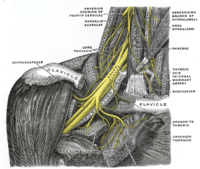
Photo from wikipedia
Abstract Background Restoring elbow function is challenging after late presenting brachial plexus birth injury (BPBI). Free functioning muscle transplantation (FFMT) using the gracilis muscle is a reliable procedure to restore… Click to show full abstract
Abstract Background Restoring elbow function is challenging after late presenting brachial plexus birth injury (BPBI). Free functioning muscle transplantation (FFMT) using the gracilis muscle is a reliable procedure to restore elbow flexion in patients with impaired function after spontaneous recovery or failed surgical reconstruction. Methods A retrospective review was performed on BPBI patients more than 2 years of age who received a FFMT between January 1993 and January 2018, with the aim of improving elbow flexion as the primary or secondary functional goal. Patients with preoperative elbow flexion Medical Research Council (MRC) grades less than 3 with more than or equal to 18 months of follow-up duration were included in the analysis. Patient demographic information and pre/postoperative clinical parameters including elbow flexion MRC scale, passive elbow range of motion, and complications were recorded. Surgical data including donor nerve choice, site of the FFMT tendon attachment, and necessity of concomitant procedures or reoperation were also analyzed. Results Fifty-six FFMTs were performed for the primary (29 patients) or secondary (26 patients) objective of restoring elbow flexion. The mean age at the time of the procedure was 9.6 years (standard deviation [SD] = 6.29, R = 3-35). Mean follow-up was 7.9 years (SD = 5.2). Elbow flexion improved from a median MRC grade 2 to 4 after a FFMT ( p < 0.05). Patients who had a FFMT to restore two functions had 86% lower elbow flexion MRC grades than those who had a FFMT to restore flexion only ( p < 0.05). Patients less than 12 years old at the time of surgery had more complications, reoperations, and rates of a flexion contracture more than or equal to 30 degrees than those aged more than 12 years ( p < 0.05). Conclusion FFMT is a reliable option for upper extremity reanimation. Patients aged less than 12 years old at the time of FFMT had significantly more complications, reoperations, and rates of postoperative elbow flexion contracture more than or equal to 30 degrees, but equivalent elbow flexion MRC grades. Level of Evidence III
Journal Title: Journal of Reconstructive Microsurgery
Year Published: 2022
Link to full text (if available)
Share on Social Media: Sign Up to like & get
recommendations!